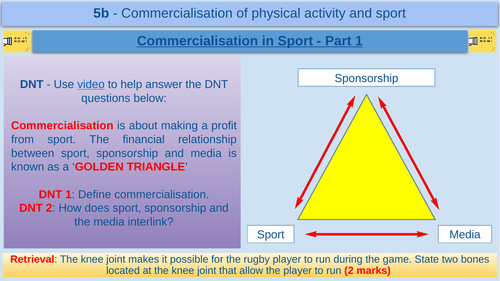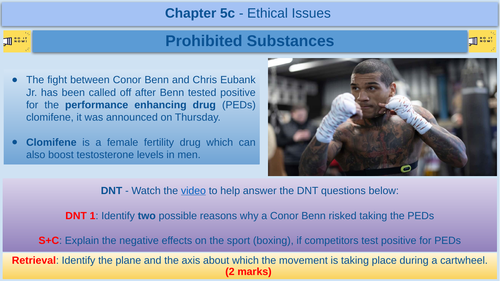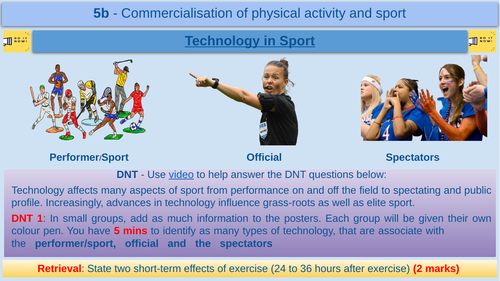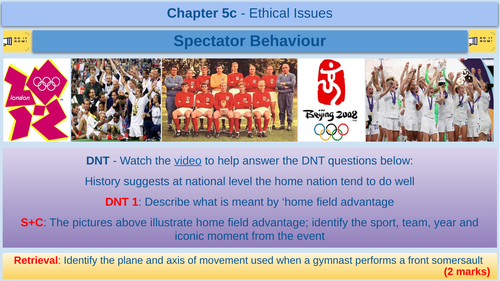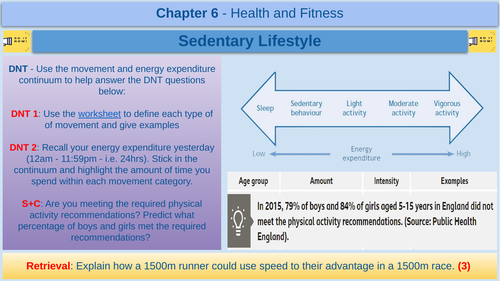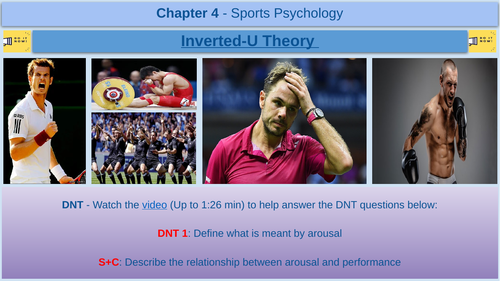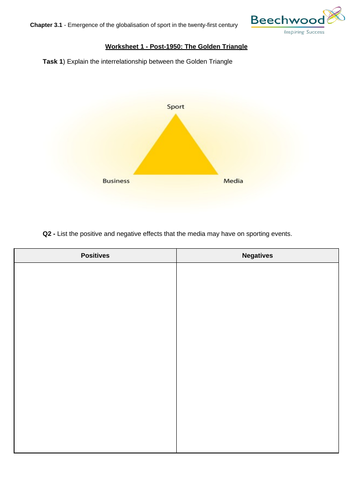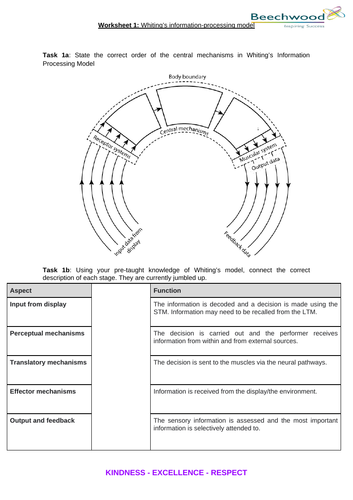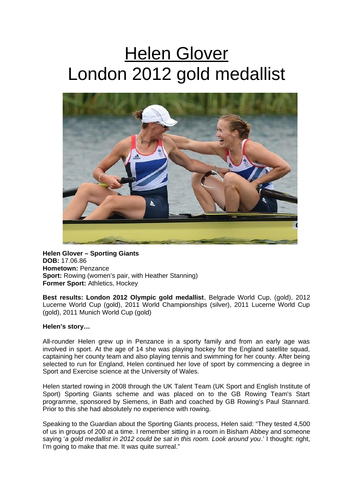
221Uploads
34k+Views
7k+Downloads
Physical education

Participation: Disability (Part 3) - GCSE Physical Education - AQA
Resource includes PowerPoint presention and differentiated worksheets for a 1 hour lesson, following the AQA specification.
Chapter 5a - Socio-cultural influences
Lesson 1: Participation: Age and Gender
Lesson 2: Participation: Family, Friends, Race, religion and culture in sport
Lesson 3: Participation: Disability and inclusion in sport

Commercialisation in Sport - Part 1 - GCSE Physical Education - AQA
Resource includes PowerPoint presention and differentiated worksheets for a 1 hour lesson, following the AQA specification.
5b - Commercialisation of physical activity and sport
Lesson 1: Commercialisation in Sport - Part 1
Lesson 2: Commercialisation in Sport - Part 2
Lesson 3: Technology in Sport

Prohibited Substances - GCSE Physical Education - AQA
Resource includes PowerPoint presention and differentiated worksheets for a 1 hour lesson, following the AQA specification.
Chapter 5c - Ethical Issues
Lesson 1 - Players’ conduct
Lesson 2 - Prohibited Substances
Lesson 3 - Spectator Behaviour

Technology in Sport - GCSE Physical Education - AQA
Resource includes PowerPoint presention and differentiated worksheets for a 1 hour lesson, following the AQA specification.
5b - Commercialisation of physical activity and sport
Lesson 1: Commercialisation in Sport - Part 1
Lesson 2: Commercialisation in Sport - Part 2
Lesson 3: Technology in Sport

Spectator Behaviour - GCSE Physical Education - AQA
Resource includes PowerPoint presention and differentiated worksheets for a 1 hour lesson, following the AQA specification.
Chapter 5c - Ethical Issues
Lesson 1 - Players’ conduct
Lesson 2 - Prohibited Substances
Lesson 3 - Spectator Behaviour

Health, well-being and fitness - GCSE Physical Education - AQA
Resource includes PowerPoint presention and differentiated worksheets for a 1 hour lesson, following the AQA specification.
Chapter 6 - Health and Fitness
Lesson 1: Health, well-being and fitness
Lesson 2: Sedentary Lifestyle
Lesson 3: Somatotypes
Lesson 4: Diet and Energy Sources

Sedentary Lifestyle - GCSE Physical Education - AQA
Resource includes PowerPoint presention and differentiated worksheets for a 1 hour lesson, following the AQA specification.
Chapter 6 - Health and Fitness
Lesson 1: Health, well-being and fitness
Lesson 2: Sedentary Lifestyle
Lesson 3: Somatotypes
Lesson 4: Diet and Energy Sources

Somatotypes - GCSE Physical Education - AQA
Resource includes PowerPoint presention and differentiated worksheets for a 1 hour lesson, following the AQA specification.
Chapter 6 - Health and Fitness
Lesson 1: Health, well-being and fitness
Lesson 2: Sedentary Lifestyle
Lesson 3: Somatotypes
Lesson 4: Diet and Energy Sources

Commercialisation in Sport - Part 2 - GCSE Physical Education - AQA
Resource includes PowerPoint presention and differentiated worksheets for a 1 hour lesson, following the AQA specification.
5b - Commercialisation of physical activity and sport
Lesson 1: Commercialisation in Sport - Part 1
Lesson 2: Commercialisation in Sport - Part 2
Lesson 3: Technology in Sport

Inverted-U Theory - Arousal and Stress Management - GCSE Physical Education - AQA
Resource includes PowerPoint presention and differentiated worksheets for a 1 hour lesson, following the AQA specification.
Chapter 4 - Sports Psychology
Lesson 1 - Classification of Skills
Lesson 2: SMART Targets
Lesson 3: Information Processing Model
Lesson 4: Types of Guidance
Lesson 5: Types of Feedback
**Lesson 6: Inverted-U Theory - Arousal and Stress Management **
Lesson 7: Aggression
Lesson 8: Personality Types & Motivation

Post-industrial Britain and the impact on sport
Chapter 3.1 - Emergence of the globalisation of sport in the twenty-first century
Resource includes PowerPoint presention and differentiated worksheets for a 1 hour lesson, following the AQA specification.
Students will be able to:
AO1: To know the characteristics of industrial Britain (1780 - 1840)
AO2: To apply these characteristics to rational recreation
AO3: To begin to evaluate how social-cultural factors affected sport during the industrial revolution
Feedback is welcome, please check out the rest of my lessons.

Rationalisation of Sport
Chapter 3.1 - Emergence of the globalisation of sport in the twenty-first century
Resource includes PowerPoint presention and differentiated worksheets for a 1 hour lesson, following the AQA specification.
Students will be able to:
AO1: To know the characteristics to rational recreation
AO2: To apply these characteristics to football, lawn tennis and athletics
AO3: To begin to evaluate how social-cultural factors affected sport during the industrial revolution
Feedback is welcome, please check out the rest of my lessons.

Post-1950: The Golden Triangle
Chapter 3.1 - Emergence of the globalisation of sport in the twenty-first century
Resource includes PowerPoint presention and differentiated worksheets for a 1 hour lesson, following the AQA specification.
Students will be able to:
AO1: To know interrelationship between commercialisation (including sponsorship), media (radio, TV, satellite, internet and social media) and sports and governing bodies.
AO2: To apply this knowledge to modern day sport
AO3: To evaluate the Golden Triangles impact to sport
Feedback is welcome, please check out the rest of my lessons.

Amateurism and Professionalism
Chapter 3.1 - Emergence of the globalisation of sport in the twenty-first century
Resource includes PowerPoint presention and differentiated worksheets for a 1 hour lesson, following the AQA specification.
Students will be able to:
AO1: To know the characteristics of amateurism and professionalism
AO2: To apply the impact of amateurism and professionalism to rational recreation
AO3: To evaluate the impact of amateurism and professionalism
Feedback is welcome, please check out the rest of my lessons.

Dietary Supplements
Chapter 4.1 - Diet and nutrition and their effect on physical activity and performance
Resource includes PowerPoint presention and differentiated worksheets for a 1 hour lesson, following the AQA specification.
Students will be able to:
AO1: To identify the positive and negative effects of dietary supplements
AO2: To apply the effects of diet supplements on sports performance
AO3: To evaluate the suitability of dietary supplements
Feedback is welcome, please check out the rest of my lessons.

Whiting’s information processing model
Chapter 9.1 - Information Processing
Resource includes PowerPoint presention and differentiated worksheets for a 1 hour lesson, following the AQA specification.
Students will be able to:
AO2: To illustrate and explain Whiting’s model of information processing
AO2: To apply this knowledge to sporting situations
AO3: To analyse each the aspects of the model
Feedback is welcome, please check out the rest of my lessons.

Baddeley and Hitch’s working memory model
Chapter 9.1 - Information Processing
Resource includes PowerPoint presention and differentiated worksheets for a 1 hour lesson, following the AQA specification.
Students will be able to:
AO1: To describe the key features and functions of the working memory model
AO2: To apply this knowledge to sporting situations
AO3: To analyse how Baddeley and Hitch’s model allows a performer to make effective decisions
Feedback is welcome, please check out the rest of my lessons.

Response Time
Chapter 9.1 - Information Processing
Resource includes PowerPoint presention and differentiated worksheets for a 1 hour lesson, following the AQA specification.
Students will be able to:
AO1: To describe reaction time, response time, movement time and the relationship between them
AO2: To explain the theories that outline the factors affecting response
AO3: To analyse the strategies a coach could use to improve response time
Feedback is welcome, please check out the rest of my lessons.

Development of elite performers in sport
Chapter 13 - Sport and society and the role of technology in physical activity and sport
Resource includes PowerPoint presention and differentiated worksheets for a 1 hour lesson, following the AQA specification.
Students will be able to:
AO1: To identify personal, social and cultural factors needed to support progression from talent identification to elite performance
AO2: To explain roles, purpose and relationship between organisations in providing support and progression from talent identification to elite performance
AO3: To analyse how support provided by the National Institutes of Sport help improve elite performance
Feedback is welcome, please check out the rest of my lessons.

Self-efficacy and Confidence
Chapter 12.1 - Psychological factors that can influence an individual in physical activities
Resource includes PowerPoint presention and differentiated worksheets for a 1 hour lesson, following the AQA specification.
Students will be able to:
AO1: To identify the factors affecting self-efficacy and confidence
AO3: To analyse both Vealey and Bandura’s models on sports confidence
AO3: To discuss possible strategies used to develop sport confidence
Feedback is welcome, please check out the rest of my lessons.


